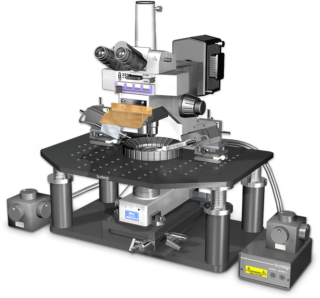Nikon’s Museum of Microscopy
Eclipse PhysioStation
( 1998 )
The Nikon Eclipse PhysioStation was specifically designed in the late 1990s for patch clamp electrophysiological experiments. Known also as the Eclipse E600FN, the upright trinocular research microscope features a specimen clearance angle of 45 degrees, which facilitates trouble-free micromanipulations.

Based on the Eclipse E600 biological microscope, the Nikon E600FN is best suited to the research needs of physiologists. To increase the rigidity and stability of the microscope stand, the thickness of the optical arm casting was increased and the substage was fused to the main microscope body. The structural alterations enable the E600FN to carry a large, cooled CCD camera without vibration while specimens are micromanipulated and imaged. An external power supply and the option to turn off the machine's click stop capability further help suppress vibration and unwanted electrical noise as does the focusing mechanism that moves only the nosepiece, rather than the entire microscope arm. Also, for ergonomic comfort, vibration control, and safety, the microscopist may alter the position of the fine-focus knob.
Eclipse E600FN microscopes are manufactured so that they may be used with a variety of attachments, modules, and illuminators in a choice of configurations. Illustrated above, the microscope system configuration features a fully adjustable and vibration-free Burleigh Instruments Gibraltar work platform and X-Y translational stage. Mass and additional stability are provided to the microscope system through the addition of the work platform, which can bear loads of up to 110 pounds. Piezoelectric actuators, which are controlled by two Burleigh micromanipulators, allow an operator to rapidly, but precisely manipulate living tissues and other objects via two pipettes.
Today the Eclipse PhysioStation is succeeded by the Eclipse FN1 upright microscope.













